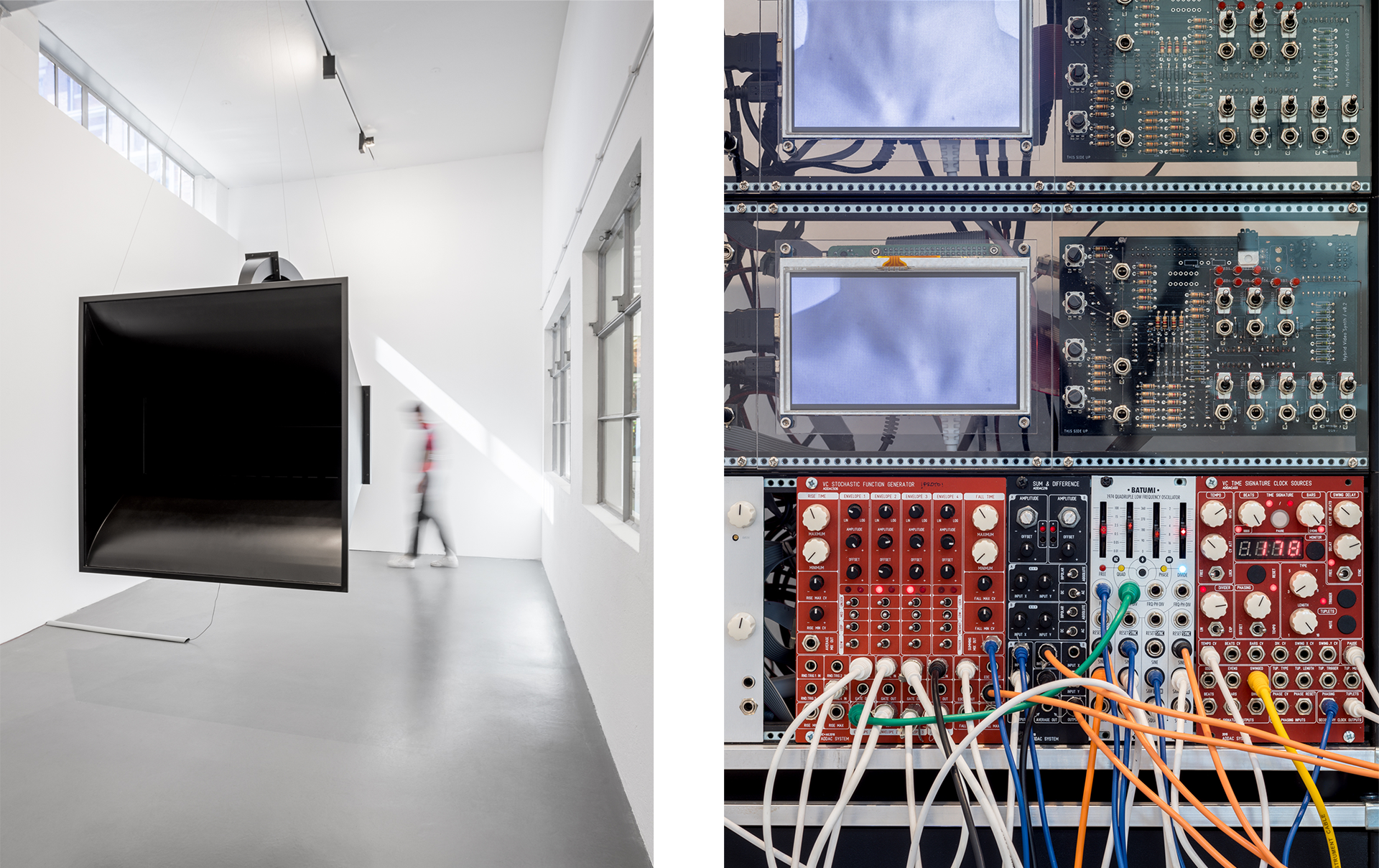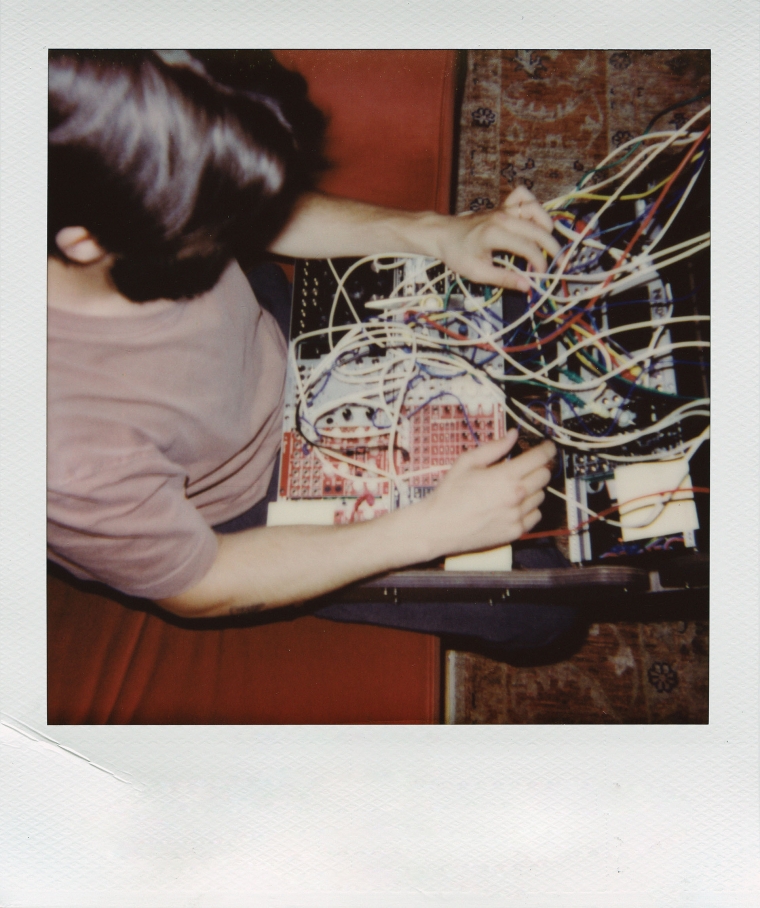

|
Views of Poly-Free (2022) by João Pimenta Gomes installed at Gabinete (maat, 29/04–20/06/2022). Photos: Vasco Stocker de Vilhena, courtesy of EDP Foundation / maat. |
João Pimenta Gomes (Lisbon, 1989) Poly-Free, 2022
Metavox (Tiptop Happy Ending Kit, Doepfer A-119, custom Eurorack video players, ADDAC405, ADDAC506, ADDAC216, XAOC Batumi, ADDAC403, Doepfer A-124, Doepfer A-106-5, ADDAC603, Doepfer A-123-2, Doepfer A-101-2, Clouds DIY, Mutable Instruments Clouds, Make Noise Erbe-Verb, 1010 Music Bitbox Micro, XOR Nerdseq, Music Thing Radio Music, ADDAC112, ADDAC402, DIY Turing machine, Doepfer A-141-2, Mutable Instruments Veils and ADDAC802), replica of Western Electric15A, Celestion AN2075 and power amplifier E-800 dimensions variable |
"Steve Lacy spoke of his transition from what he called the “hermetic-free” of total improvisation, which he explored in depth in the 1960s, to something termed “poly-free”. This could entail any combination at all of unpremeditated interplay, fully scored music with melodies and rhythms and harmony, graphic scores, vague verbal directions, games, role-playing, or the use of a conductor. …
The impetus in Lacy’s case came from the creeping feeling he had that there was starting to be a “correct” way to freely improvise, that expectations were mounting and an aesthetic was developing, and that this was fastening at least into a routine, perhaps even into a protocol.
— John Corbett, A Listener’s Guide to Free Improvisation, 2016
"Every sound was created by Carminho singing the Harry Partch scale note by note using different “articulations” (aaaahs, taaaaas, eeeehs, etc.). I broke all of the notes down individually and it left me with a kit of one-shots that I used for this piece.
— João Pimenta Gomes on his work Doppelgänger (with Carminho and Harry Partch), 2021
The Real Sound
João Pinharanda
João Pimenta Gomes renders music through synthesizers that he programmes himself, also using them to decompose the human voice. He creates scores that define rules but which also allow successive moments of improvisation, while simultaneously creating self-regulated programmes that allow him to prolong his performances infinitely.
His work inserts us into a different time and space to that we traditionally devise for the production and listening of music. They are defined by the desire to think about his pieces in terms of spaces that precede them (and whose conditions he has no intention to change – thus they cannot be regarded as sound works) and for ambiguous time limited by the duration of each performance, but released from these limits by the “generative” solution that outlives them (as the memory of images outlives the moment of immediate contemplation). In other words, space and time are marked by his experience in the field of the visual and plastic arts.
Poly-Free (2022) presents something new. It is emitted from a device which, retrieved from the archaeological archives of sound amplification (Western Electric 15A, 1920s), takes the form not merely of a real musical instrument (through which the artist complements and amplifies the multiplicity of his synthesisers) but of a real sculpture.
The sound produced by the device is monophonic, which Pimenta Gomes gives greatest importance: the refusal of the illusion of real sound produced by stereophony is part of his working assumptions for this piece. The artist limits his resources to the minimum here: he renders a restricted nucleus of sounds (voice) through a limited number of rules of composition and models of improvisation; he hands the entire visual protagonism to the amplifier of these sounds by giving them decisive plastic support; he places his (sculptural/sound) piece in the specific surroundings of an exhibition space. In other words, while defining or better locating the place of his discourse at the margins of the plastic arts, the double channel in which his work is developed is left open – above all the examination of the history of experimental and improvised music that gives this piece its title.
|
Gabinete (or Cabinet) reinstates the original name of a room at Central Tejo, now with the function of a new space at maat for the exhibition of small nuclei of works by Portuguese artists. Programmed by João Pinharanda, maat director.
|
João Pimenta Gomes (Lisbon, 1989) is a visual artist and musician that lives and works in Lisbon. In his artistic practice, he addresses references mostly related to music and explores the relationships between space and body through by manipulating modular synthesisers, images and objects, enabling encounters between the analogue and the digital, the sensory and the conceptual. His most notable exhibitions include Clouds (Kunstraum Botschaft, Berlin, 2021), Trabalho de Inverno (Galeria Quadrado Azul, Lisbon, 2021), as member of the group Matéria Simples, with whom he also held A Ilha de Calipso (Appleton Garagem, Lisbon, 2020), and Micro Ressonâncias (Appleton Box, Lisbon, 2020).
|









